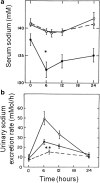Clinical and Molecular Features of Thiazide-Induced Hyponatremia
- PMID: 29637415
- PMCID: PMC5893690
- DOI: 10.1007/s11906-018-0826-6
Clinical and Molecular Features of Thiazide-Induced Hyponatremia
Abstract
Purpose of review: Hypertension affects more than 30% of the world's adult population and thiazide (and thiazide-like) diuretics are amongst the most widely used, effective, and least costly treatments available, with all-cause mortality benefits equivalent to angiotensin-converting enzyme inhibitors or calcium channel antagonists. A minority of patients develop thiazide-induced hyponatremia (TIH) and this is largely unpredictable at the point of thiazide prescription. In some cases, TIH can cause debilitating symptoms and require hospital admission. Although TIH affects only a minority of patients exposed to thiazides, the high prevalence of hypertension leads to TIH being the most common cause of drug-induced hyponatremia requiring hospital admission in the UK. This review examines current clinical and scientific understanding of TIH. Consideration is given to demographic associations, limitations of current electrolyte monitoring regimens, clinical presentation, the phenotype evident on routine clinical blood and urine tests as well as more extensive analyses of blood and urine in research settings, recent genetic associations with TIH, and thoughts on management of the condition.
Recent findings: Recent genetic and phenotyping analysis has suggested that prostaglandin E2 pathways in the collecting duct may have a role in the development of TIH in a subgroup of patients. Greater understanding of the molecular pathophysiology of TIH raises the prospect of pre-prescription TIH risk profiling and may offer novel insights into how TIH may be avoided, prevented and treated. The rising prevalence of hypertension and the widespread use of thiazides mean that further understanding of TIH will continue to be a pressing issue for patients, physicians, and scientists alike for the foreseeable future.
Keywords: Diuretics; Hypertension; Hyponatremia; TIH; Thiazide; Thiazide-induced hyponatremia.
Conflict of interest statement
Conflict of Interest
The authors declare no conflicts of interest relevant to this manuscript.
Human and Animal Rights and Informed Consent
This article does not contain any studies with human or animal subjects performed by any of the authors.
Figures


References
-
- N.I.C.E. Hypertension: clincial management of primary hypertension in adults. Clinical guideline 2011 [cited 2014 May 1st]; CG127:[Available from: https://www.nice.org.uk/guidance/cg127.
-
- W.H.O., GLOBAL HEALTH RISKS: Mortality and burden of disease attributable to selected major risks. 2009, WHO Press: World Health Organization, 20 Avenue Appia, 1211 Geneva 27, Switzerland p 1-70.
-
- NHS. Health Survey for England -2006, CVD and risk factors for adults, obesity and risk factors for children. 2006 [cited 2018; Available from: http://digital.nhs.uk/catalogue/PUB01213.
Publication types
MeSH terms
Substances
Grants and funding
LinkOut - more resources
Full Text Sources
Other Literature Sources
Medical
Research Materials

